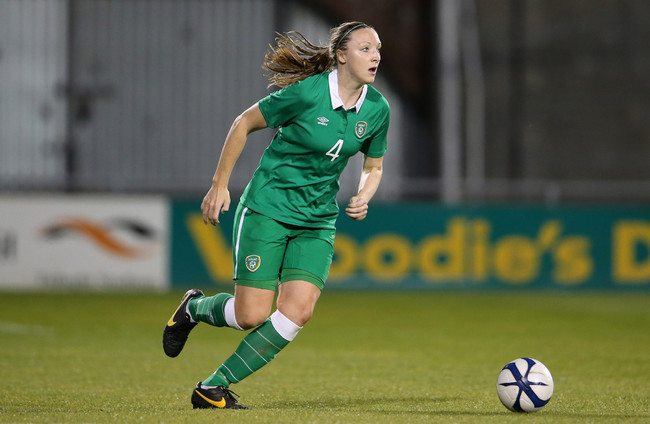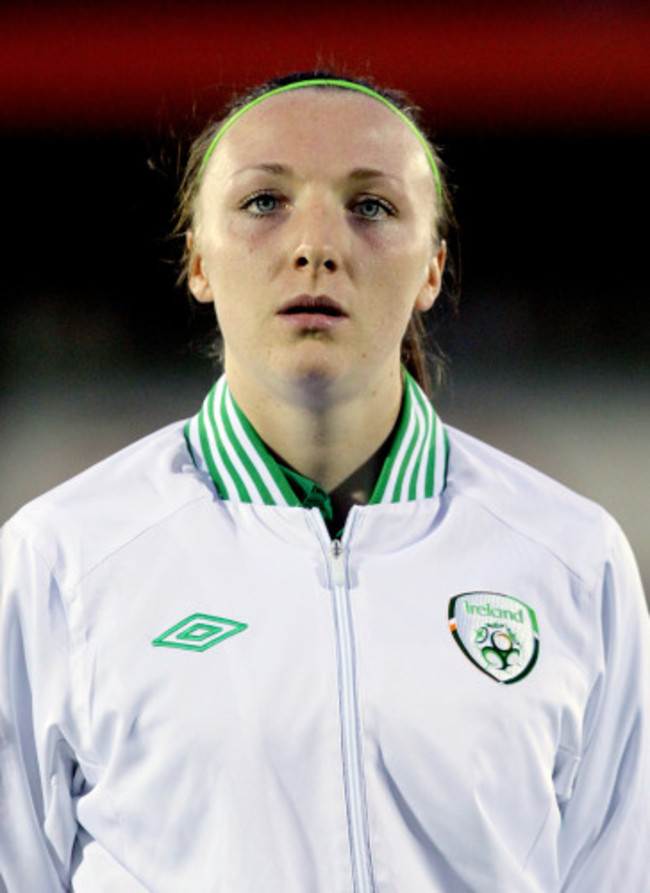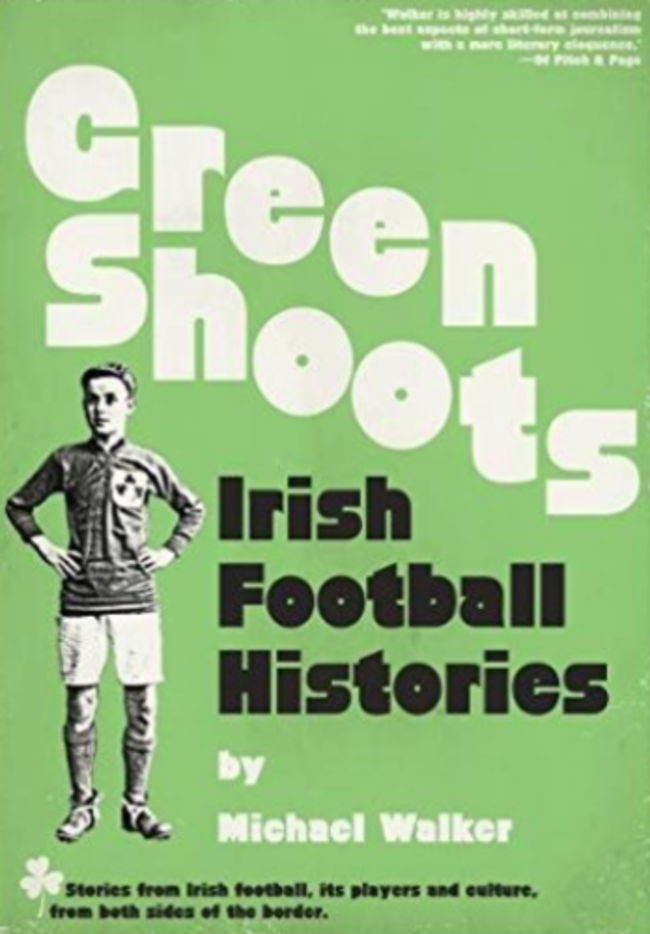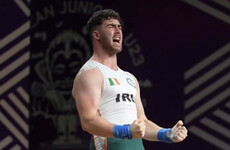THE FOLLOWING PASSAGE is an extract from Green Shoots: Irish Football Histories by Michael Walker.
“We won 4-1 but, oh, I had a terrible game. The ball was bouncing off me, going everywhere. Our coach didn’t think that, he thought we were playing like the Harlem Globetrotters. But the nerves really got to me. Thankfully it turned out to be the start of a really successful season.”
Louise Quinn is looking back at her debut for a club called Eskilstuna United in the second division of Swedish women’s football. It was April 2013, Quinn was 22, and she felt a long way from Wicklow and Peamount United.
By the time she left, four seasons later, Eskilstuna had come a close second in the top division and played in the Champions League. Louise Quinn was described in Swedish newspapers as ‘fundamental’, ‘a defensive rock’ and ‘a real servant who didn’t miss a minute’s play.’ There were 324 locals at her home debut; two years later when Eskilstuna played Goteborg, there were 6,300 at the club’s Tunavallen stadium.
The attendance spike is why in Sweden they refer to ‘the phenomenon of Eskilstuna’, a small city west of Stockholm where the women’s football team is more popular than the men’s. Quinn, who started out as a seven year-old playing for Blessington Boys, became a significant part of that. As they said, fundamental.
“It was exciting, it was the unknown, the second tier of Swedish football,” Quinn says.
“In the first couple of home games there were only two or three hundred people there but we kept grinding out wins and the club kept pushing it off the pitch, they were really good at promoting it. We’d be on social media, attending events around the town, going to schools, I’ve been standing in a thunderstorm at a shopping centre handing out leaflets. The people in the town felt we cared about them.”
The town responded, enabling a club formed in 2002 to sign and sustain players 132 such as Quinn on full-time contracts. That in turn gave her a taste of professionalism and the knowledge that she could make a career, economically, from the growing interest in the women’s game.
The thought had entered Quinn’s mind seriously in 2011, when Peamount had made it to the Champions League and faced Paris St-Germain.
“Getting through to that stage was massive for Peamount,” Quinn says. “But when you got there you saw the standard, where the rest of Europe was and where Ireland was. It was a bit of a reality check. It was about fitness and technique but also about the coaching structure around you. We did compete with PSG but in the end their fitness told. It was then that I started to think: ‘Could I go abroad? Would I be good enough?’”
There were coaches in Ireland who would have answered Quinn in the affirmative. This after all was a defender capped at U17 level when she was 14. Or as Quinn puts it: “14 going-on 15 – I was a very large 14 year-old.” She became a full Ireland international at 17.
But Quinn had doubts. When asked if playing U17 football at 14 was not a sign of talent, she answers: “Well, yes and no.” She had not been on the same school-system route that other girls in the international set-ups had come through. Plus, at 15, she fractured a hip and was out for 10 months.
Furthermore, Quinn’s mother Jacinta and father John, a County Wicklow Gaelic footballer, were eager for their third daughter of three sisters to complete her education. Quinn did that, getting a degree from University College Dublin in Sports and Exercise Management.
The emphasis on study, while playing for Peamount, meant that it was only when her degree was ending that Quinn used the video technology of FAI performance analyst Gerard Dunne at the course in Carlow to create a highlights package. A friend with an agent in the women’s game had suggested this. That was, Quinn says, ‘around November-December 2012’.
By February 2013 she was signing a one-year full-time contract with Eskilstuna.
Transfers aren’t massive in women’s football and there wasn’t a lot of head-hunting five years ago,” she says. “I was told Eskilstuna was a good club, an up-and-coming club that wanted to push on. They were in the second tier, but I thought that might be a good starting point for me. ‘Will I like it?’ ‘Will I be good enough?”
“What helped was that a friend from Peamount, Vaila Barsley, was also joining. She’s a centre-back as well and we were thinking: ‘Do they need two?’ But she’s similar, about 6ft, loves defending, heading the ball, we became a partnership. I was just very excited and my Mum and Dad were brilliant. My Dad always says: ‘Any opportunity, take it.’’
A wage coming in, accommodation provided, Quinn endeavoured to settle into a full-time regime where a squad of 16-18 players trained every day. She was to make it work, but there were moments of hesitation along the way. The first day, for example.
“There was about a foot and a half of snow and I was thinking: ‘Where am I? There were even some Swedes who hadn’t heard of Eskilstuna United. And the first session was in the gym and I wasn’t very educated in that, not like the Swedes who do some of that in school. Sweden is a very fit and healthy nation. It was a bit daunting alright and the snow stuck around for two or three months. But when we got on the pitch, I felt a lot more comfortable.”
Quinn experienced the long, deep, dark Swedish winter in which Eskilstuna would train in minus 18 temperatures — “Oh, yeah, frozen eyelashes, frozen hair, and I still had that Irish reluctance to wear proper clothes.”
But something was coming together at Eskilstuna United. They won promotion in Quinn’s first season and then finished a respectable seventh in the top flight in her second season. In her third, Eskilstuna finished just a point behind Rosengard, an established power in Sweden’s women’s game.
“When we were getting promoted people started coming and just clung onto it,” Quinn says of the effect on the population – around 70,000.
“It was the most successful team in Eskilstuna and people were enjoying what we were doing. As more fans came, the more we said: ‘Let’s keep this up.’”
The stadium was shared with two men’s teams and had about 6,000 seats. We’d some great wins after promotion and we’d some local players, which helps. In the third season, when we finished second, we should have won it. But we didn’t have the experience, nerves kicked in and we’d a tough run-in. We felt the pressure, even the coach. And Rosengard, on paper, they’d the bigger names.’
One of those Rosengard names was Marta, the Brazilian regarded as the greatest-ever female footballer.
Second place in 2015 meant Champions League football in 2016, however, and Eskilstuna beat Glasgow City, then faced Wolfsburg. Those were two different propositions, the Germans playing at a higher level altogether. The 3-0 defeat at Wolfsburg was Quinn’s last game for Eskilstuna.
It was November 2016. She had signed one-year contracts and at the end of that fourth season, Quinn sat down to reflect on where she was in her career. She was 25 and could see money being invested in the French league, the English league. She had just seen the standard of German football.
There was an itch. She could speak some Swedish but found that when she tried to do so in social circles, the replies were in English. The coaching sessions were also held in English.
I know the language but I’m not fluent in it. The club didn’t make me learn it and I wasn’t massive into languages at school because of the form of dyslexia I have. I found that tough, I’d have Swedes saying: ‘Why don’t you know the language yet?’
“I found it tough to make friends outside football and I do like to have that, so I’m not thinking about football all the time. I’d a good social circle in Ireland. And the Swedish winters are long and they’re just dark and grey before the snow comes in January and February.”
Another unexpected thing Quinn noticed was that Swedes constantly called her British, not Irish. There would be media references to her and Barsely such as ‘the two British centre-backs were dominant’. Barsley was unperturbed — she is English — but Quinn was bemused.
“I’m still educating them on Ireland. They always called me British and when I said: ‘I’m Irish’, they’d say, well, you come from the British Isles. I told them that was old-school geography.”
Quinn’s personal geography was about to change. A ‘homebird’, she flew back to Ireland, then heard about an offer from Notts County in England’s Women’s Super League.
“Sweden definitely shaped me as a player. I was learning the whole time, new formations, training every day. I had given every ounce I had to the team but I needed a new challenge. I just took a chance on Notts Co.”
If Eskilstuna United was a risk that paid off, a new experience in another part of the world, Notts Co. was a blast of a different kind of reality. Two days before they were due to play Arsenal in the 2017 WSL season opener, the squad was called to Meadow Lane and informed the club had been liquidated.
It was brutal,” Quinn says. “I knew a little bit about the club, that there was a new owner and that they’d signed the likes of myself and re-signed the girls already there. But when we got a text to tell us to be at the ground the next day for 11, that training was cancelled – not re-scheduled, cancelled – then you fear the worst. And it was the worst. There was a lot of anger, tears, it was very confusing. Some girls even asked if we would still be playing on the Sunday. ‘No, this is it.’’’
Because of what happened next, Quinn feels conflicted. She feels most for the players who had settled, arranged places to live and planned their lives around Notts Co. But when she called her agent, she was told that Arsenal were looking for a centre-half and she was it. A week after Notts Co. folded Quinn was on the bench for Arsenal.
“I did have mixed emotions. I felt bad – I was with Arsenal and we were supposed to be playing them. I’m glad the majority of the Notts Co. girls got sorted.”
Green Shoots: Irish Football Histories by Michael Walker is published by De Coubertin Books. More info here.
The42 has just published its first book, Behind The Lines, a collection of some of the year’s best sports stories. Pick up your copy in Eason’s, or order it here today (€10):














Crazy decision. Completely accidental clash of heads.
A five game ban for this is outrageous. How is a decision like that arrived at. It was clearly accidental.
Cant watch the clips because I’m in Australia ffs. But the fans I’ve spoke to say it’s a yellow a most and even that’s harsh. Any truth to this??
@Dara: no
@Dara: Do they not have YouTube in Australia ?
Shameful decision. Warranted a yellow card at best. He’ll be badly missed for the ECC games where his brawn and explosive speed would have levelled things up for Connacht.
Whatever about whether it was right or wrong, how can they suspend 1 week off the 6 week ban for ‘remorse’ when the red card was challenged? Surely that is a prime indication that not alone was there no remorse but the feeling was that it wasn’t even a red card. This incident aside, I would be concerned that the judicial process is flawed on that basis.
His biggest mistake was not being Owen Farrell.
I think he’s a lucky lad to only get 5 weeks, accidental or not he clearly didn’t learn his lesson from the last high shot.
@Jim Demps: I don’t think people here understand. The tackler has an obligation to tackle safely. Accidental or not he has made head to head contact which could have been avoided. The player doesn’t dip in fact he may even come up a little at impact. It’s a clear red and when it’s your second of the season 5 weeks seems lenient.
@Jim Demps: It was an accidental clash of heads after the attacking player changed his running line. I think 5 weeks is harsh, I’d love to see how they arrived at this decision. He does need to lower his tackle height though. Owen Farrell only got 5 weeks for tackle on Charlie Atkinson and in terms of intent those tackles are like chalk and cheese. With Farrells tackling track record it should have been far longer.
@Jayme Mc Goldrick: yeah that’s it. Accidental or not the outcome is still a dangerous tackle. I get why people are annoyed, I’d probably be the same if it was a munster player but it’s not like it’s a new rule, a head shot has never been legal.
@MacEoin.T: I think the decision is pretty clear, he got 6 weeks the first time and it was reduced to 3 for having a clear record. He then got 6 weeks this time and didn’t get the reduction for having a clear record. If anything I’d be saying he didn’t deserve the one week reduction given he clearly hasn’t learnt his lesson.
@Jim Demps: Out of interest, does a player get a clear record at the beginning of each season or is it a pro career duration timeframe?
@MacEoin.T: I know in the amateur game in Ireland they look at your records for 5 years so I assume it’s probably something similar. They definitely don’t get a clean slate at the start of the season anyway. Punishing repeat offenders more harshly I think is a good way to go. Like if Papalli gets sent off again for another high shot I’d say he could be looking at 10+ weeks.
@Jim Demps: he’ll be back in time for the game against Munster on the 9th of January Jim. We’ll get a proper look at him in action then.
@Jim Demps: Would you stop Jim, Farrell got the same ban for trying to take Atkinson’s head off and you’re arguing the Papali’i deserves the same? You’re dreaming lad.
@Paddy Kennedy: I’m not arguing anything, I’m saying that’s how it works. Farrell actually got a 10 week ban reduced by half for a first offence. Farrells was worse and he got a bigger ban, papalli is in the dock for the second time in four games and gets less of a reduction. It’s fairly straightforward
@David Finn: great stuff, hopefully he takes the time between now and then to learn how to tackle in Union. He’ll be a serious player once he irons out those mistakes.
@Paddy Kennedy: It was Farrell’s first red so he got more lenient treatment. The fact that Farrell should have had plenty of reds in recent seasons can’t be taken into account.
Players & coaches have to understand how seriously World Rugby is taking head injuries and act accordingly. That means a lower body position in any potential tackle situation.
Clearly difficult to get it right all the time so some players will get unlucky from time to time. Lack of intent doesn’t seem to be a mitigating factor.
Crazy biased decision.
That makes no sense. How the ref made out he led with his head is beyond me. The attacking player steps and papali has to change direction to make the tackle, their heads collide. 5 games is ridiculous.
Outrageous decision! Ref & TMO bottled it!!
I really don’t understand all the comments arguing that this is somehow disproportionate. It was a clear red card, it was clear he was going to get a significant ban and if he doesn’t learn how to tackle lower he’s going to miss more games than he plays. Crazy decision by Connacht to contest this and I’d argue you shouldn’t get a reduction if you contest the decision, as you’re clearly not remorseful if you think you didn’t commit an offence.
The hypocrisy on this forum , when it was Peter O Mahony deliberately targeting someone’s head in the ruck with his shoulder a few weeks ago (imo, is much worse than an accidental clash of heads) people here were saying ‘he was frustrated’ and ‘playing on the edge’!